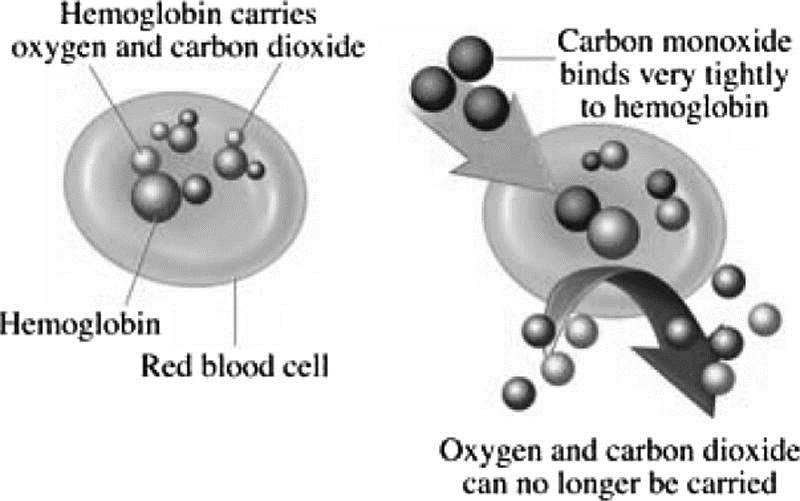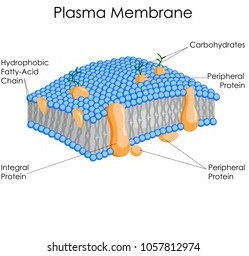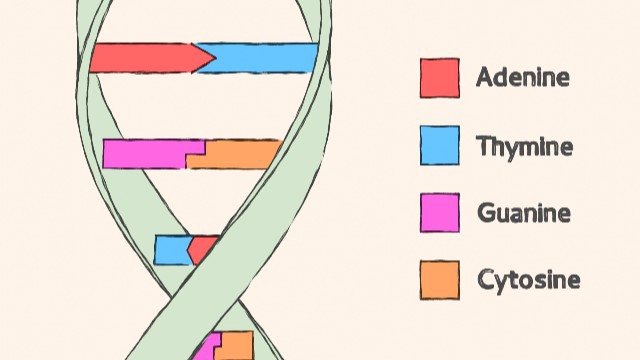Which of the following is a potential complication of carbon monoxide poisoning?
A. Conversion to carbon monoxide.
B. Formation of carboxyhemoglobin.
C. Increased production of red blood cells.
D. Decreased pulmonary function.
Formation of carboxyhemoglobin.
Carbon monoxide binds to the hemoglobin to create a molecule called carboxyhemoglobin (COHb), which interferes with the body’s ability to transport and use oxygen, especially in the brain.
 |
Choice A is incorrect because carbon monoxide poisoning occurs when carbon monoxide builds up in your bloodstream.
Choice C is incorrect because carbon monoxide poisoning does not increase the production of red blood cells.
Choice D is incorrect because decreased pulmonary function is not a potential complication of carbon monoxide poisoning.
Therefore, the Correct Answer is B.
More Questions on TEAS 7 Science
-
Q #1: A patient with chronic kidney disease is at risk for developing which of the following electrolyte imbalances?
A. Decrease in the concentration of calcium in the glomerulus.
B. Increase in the concentration of potassium in the blood.
C. Decrease in the concentration of sodium in the blood.
D. Increase in the concentration of magnesium in the blood.
Answer Explanation
The correct answer is choice B.
A patient with chronic kidney disease is at risk for developing an increase in the concentration of potassium in the blood.
The kidneys play a pivotal role in the regulation of electrolyte balance.
With progressive loss of kidney function, derangements in electrolytes inevitably occur and contribute to poor patient outcomes123.
Choice A is incorrect because calcium concentration is not regulated in the glomerulus.
Choice C is incorrect because chronic kidney disease can result in either an increase or decrease in sodium concentration in the blood.
Choice D is incorrect because chronic kidney disease does not necessarily result in an increase in magnesium concentration in the blood.
-
Q #2: What is the organelle that encapsulates the contents of the cell and plays a vital role in regulating the movement of substances in and out of the cell?.
A. Ribosome
B. Nucleus
C. Mitochondria
D. Plasma membrane.
Answer Explanation
The plasma membrane is the organelle that encapsulates the contents of the cell and plays a vital role in regulating the movement of substances in and out of the cell.
It is a selectively permeable barrier that separates the internal environment of the cell from the external environment.

Choice A is incorrect because ribosomes are organelles involved in protein synthesis, not in regulating the movement of substances in and out of the cell.
Choice B is incorrect because the nucleus is an organelle that contains the cell’s genetic material, not in regulating the movement of substances in and out of the cell.
Choice C is incorrect because mitochondria are organelles involved in energy production, not in regulating the movement of substances in and out of the cell.
-
Q #3: What is the hallmark of adaptive immunity?
A. Rapid recruitment of immune cells to sites of infection and inflammation
B. Antigen-independent defense mechanism
C. Immunologic memory
D. Non-specific host-defense mechanisms .
Answer Explanation
Immunologic memory is the hallmark of adaptive immunity.
Immunologic memory enables the host to mount a more rapid and efficient immune response upon subsequent exposure to the antigen.
Choice A is incorrect because rapid recruitment of immune cells to sites of infection and inflammation is a characteristic of innate immunity.
Choice B is incorrect because antigen-independent defense mechanisms are characteristic of innate immunity.
Choice D is incorrect because non-specific host-defense mechanisms are characteristic of innate immunity.
-
Q #4: During the menstrual cycle, which structure in the ovary produces progesterone to prepare the endometrium for potential implantation?
A. Corpus luteum.
B. Fimbriae
C. Follicle
D. Ovarian ligament.
Answer Explanation
Corpus luteum.
During the menstrual cycle, the corpus luteum in the ovary produces progesterone to prepare the endometrium for potential implantation.

Choice B is incorrect because fimbriae are finger-like projections at the end of the fallopian tubes that help guide the egg into the tube.
Choice C is incorrect because a follicle is a sac in the ovary that contains an immature egg.
Choice D is incorrect because the ovarian ligament is a fibrous band of tissue that connects the ovary to the uterus.
-
Q #5: Which type of lymphocyte is capable of killing tumor cells and infected cells without prior sensitization?.
A. Helper T cells.
B. B cells.
C. Natural killer cells.
D. Cytotoxic T cells .
Answer Explanation
Natural killer cells.
Natural killer (NK) cells are large granular lymphocytes that are capable of destroying cells infected by viruses or bacteria and susceptible tumor cells without prior sensitization and restriction by MHC antigens.
Helper T cells (choice A) are a type of white blood cell that helps other immune cells respond to infections but do not directly kill infected or tumor cells.
B cells (choice B) are a type of white blood cell that produces antibodies to fight infections but do not directly kill infected or tumor cells.
Cytotoxic T cells (choice D) are a type of white blood cell that can kill infected or tumor cells but require prior sensitization to do so.
-
Q #6: Which of the following is a consequence of increased viscosity of a fluid?
A. Particles have a decrease in mobility.
B. The fluid will have a lower density.
C. The fluid will have a higher flow rate.
D. The fluid will have a higher pressure.
Answer Explanation
The correct answer is choice A.
An increase in viscosity of a fluid results in a decrease in mobility of particles.
Viscosity is the resistance of a fluid to a change in shape or movement of neighboring portions relative to one another.
It denotes opposition to flow and may be thought of as internal friction between the molecules.
Choice B is incorrect because an increase in viscosity does not affect the density of a fluid.
Choice C is incorrect because an increase in viscosity results in a decrease, not an increase, in flow rate.
Choice D is incorrect because an increase in viscosity does not affect the pressure of a fluid.
-
Q #7: Which type of bond is responsible for the unique properties of water and plays a crucial role in the structure of DNA and proteins?
A. Hydrogen bonds.
B. Covalent bonds.
C. Ionic bonds.
D. Van der Waals forces.
Answer Explanation
The correct answer is choice A. Hydrogen bonds.
Hydrogen bonds are responsible for the unique properties of water and play a crucial role in the structure of DNA and proteins.
Hydrogen bonds are weak electrostatic attractions between a hydrogen atom covalently bonded to an electronegative atom and another electronegative atom.
Choice B.
Covalent bonds is incorrect because covalent bonds are strong chemical bonds formed by the sharing of electrons between two atoms.
Choice C.
Ionic bonds is incorrect because ionic bonds are chemical bonds formed by the transfer of electrons from one atom to another, resulting in the formation of ions.
Choice D.
Van der Waals forces is incorrect because Van der Waals forces are weak intermolecular forces that arise from temporary dipoles induced in atoms or molecules.
-
Q #8: What are the four nucleotide bases found in DNA?
A. Adenine, Thymine, Cytosine, Guanine.
B. Adenine, Thymidine, Cytidine, Guanine.
C. Adenosine, Thymine, Cytosine, Guanosine.
D. Adenosine, Thymidine, Cytidine, Guanosine.
Answer Explanation
These are the four nucleotide bases found in DNA1.

Choice B) Adenine, Thymidine, Cytidine, Guanine is incorrect because Thymidine and Cytidine are not nucleotide bases found in DNA.
Choice C) Adenosine, Thymine, Cytosine, Guanosine is incorrect because Adenosine and Guanosine are not nucleotide bases found in DNA.
Choice D) Adenosine, Thymidine, Cytidine, Guanosine is incorrect because Adenosine, Thymidine and Cytidine are not nucleotide bases found in DNA.
-
Q #9: Which hormone is responsible for the development of female secondary sexual characteristics such as breast development, menstrual cycle, and widening of hips?
A. Progesterone
B. Testosterone
C. Estrogen
D. FSH
Answer Explanation
The correct answer is choice C. Estrogen.
Estrogen is a steroid hormone responsible for the development of female secondary sexual characteristics such as breast development, menstrual cycle, and widening of hips.
Choice A, Progesterone, is not the correct answer because it is required to maintain pregnancy and delivery.
Choice B, Testosterone, is not the correct answer because it is a hormone produced by the testes which controls the development of male secondary sexual characteristics.
Choice D, FSH (Follicle Stimulating Hormone), is not the correct answer because it stimulates the growth of ovarian follicles in females and regulates spermatogenesis in males.
-
Q #10: Which of the following organelles is responsible for modifying, sorting and packaging proteins and lipids?
A. Golgi apparatus
B. Mitochondria
C. Ribosomes
D. Endoplasmic reticulum
Answer Explanation
The correct answer is choice A. Golgi apparatus.
The Golgi apparatus is a membrane-bound organelle that is responsible for transporting, modifying, and packaging proteins and lipids into vesicles for delivery to targeted destinations.
Choice B is incorrect because mitochondria are responsible for energy production.
Choice C is incorrect because ribosomes are responsible for protein production.
Choice D is incorrect because the endoplasmic reticulum is responsible for lipid production and protein production, but not for modifying, sorting and packaging proteins and lipids.
Free Access on TEAS 7 Exams and Study Notes
- Access to all TEAS 7 Exams
- Performance Tracking and Analysis
- Well Documented and Explained Questions and Answers
- 2000+ Questions and Correct Answers: Answers Well Explained
- Libary of Detailed StudyNotes
- Topical Questions and Answers on Examinable topics
TEAS 7 Exams (Q&A)
TEAS 7 Study Notes
TEAS 7 Topical Tests

TEAS 7 Study Guides
Quick Links
Refer a Friend
Refer a friend and claim free unlimited access

© 2024 ExamGates Made with by ExamGates
